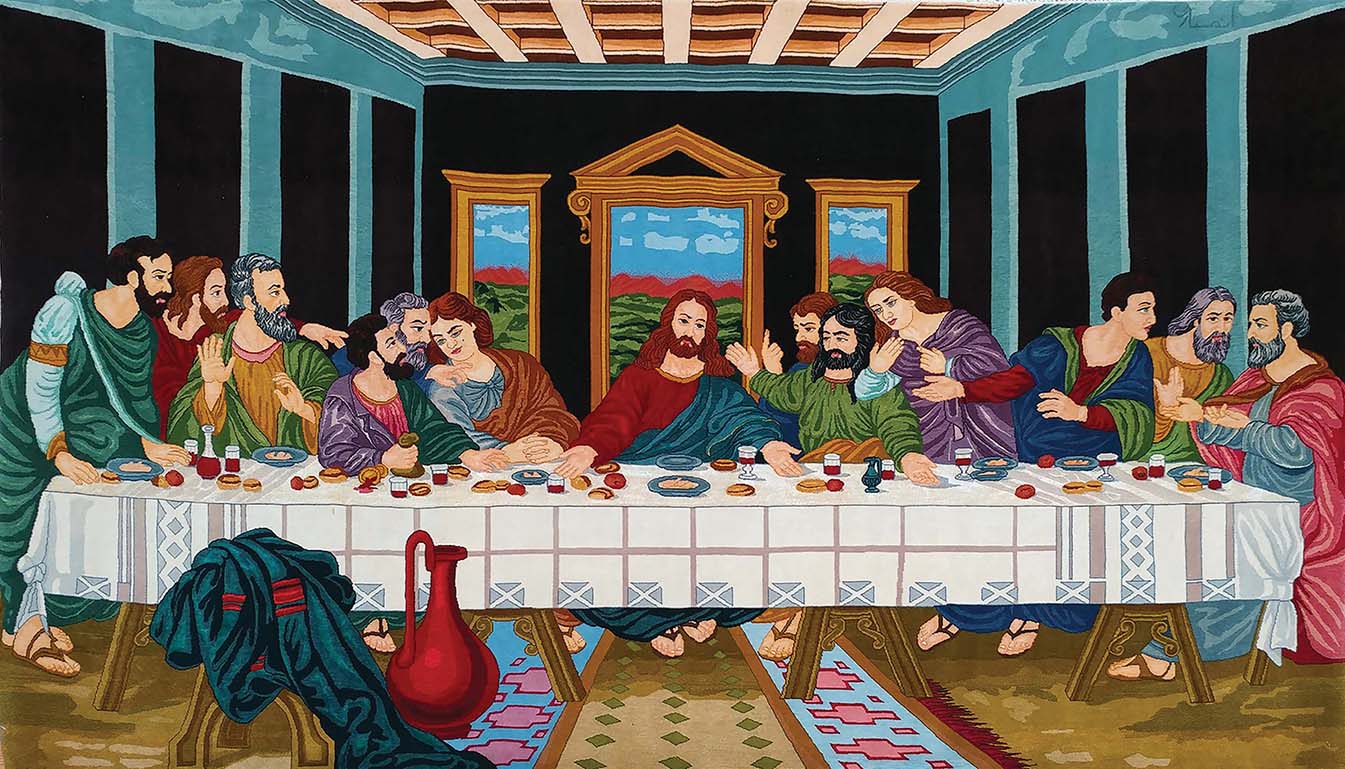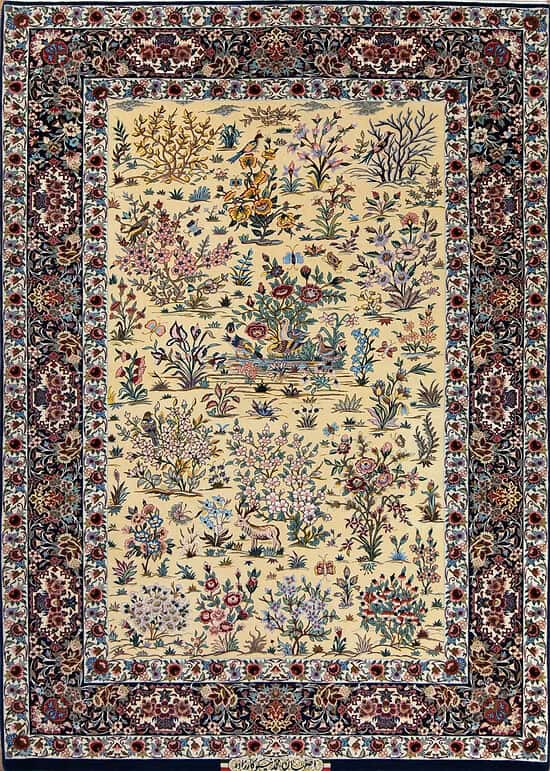Oriental rugs refer to all handmade rugs, including hand-knotted pile rugs, made in the Rug Belt region, which stretches from Morocco to Northern India, across North Africa, the Middle or Near East, and Central Asia. Although Northern China, Mongolia, and Tibet are also known for their Oriental rugs, historically, Iran (Persia) and Turkey (Anatolia) were the most central and essential regions involved in handmade rug production and trade.
The Oriental rug was a valuable commodity traded on the Silk Route (or Silk Road), which was the chief route for trade between the East and West from 200 BCE until the eighteenth century when sea routes were established. It is important to note that a machine-made Oriental design rug defines a machine-made rug that uses oriental designs. Additionally, the Oriental rug is often misused to describe a handmade Persian rug.
However, Persian rugs are, by definition, made in Iran and should be appropriately identified as such. All Oriental handmade rugs have a foundation or knotted pile made up of either cut ends or loops of extra yarn with varying pile heights. The thickness and weight of the rug increase as the measurement from the foundation to the pile end gets higher.
Rugs lacking a pile foundation are referred to as flatweaves or kilims. One can often come across the term Oriental carpet, which indicates a larger-sized rug that typically exceeds ten feet in length. Other common terms relating to rug sizes are shapes, such as round rugs, square rugs, and runner rugs. An Oriental runner rug is simply a longer-than-usual vertical-length rug used in hallways.
Other common Oriental rug types are prayer rugs, which are typically designed for one person and include a mihrab design element that symbolizes the prayer niche in the wall of a mosque. The direction of Mecca is represented by an arch (or triangle or dome) at one end of the rug. Finally, a pictorial Oriental rug represents a person or a natural or historical scene, and such rugs are often hung on walls, like paintings.
A handmade Oriental rug is created using a loom with yarns called warp yarns that run parallel to one another vertically along the length of the loom. These vertical warp yarns are tied together by hand with a knot made using a short piece of yarn between two adjacent warp yarns.
After making a row of such knots, one or more horizontal or weft yarns are passed through these vertical warp strands. The horizontal weft yarn is pulled over a gauge rod to make loops of yarn that face the weaver. This rod is either removed to leave the loops closed, resulting in a loop pile, or the loops are cut over the rod, resulting in a cut pile. Knots are compressed and firmly beaten with a tool called a comb to secure them into place.
The value of an Oriental rug is determined by the knot count, which refers to the number of knots per square inch, abbreviated as kpsi. The higher the knot count, the longer it takes to weave, and the more intricate detail and curvilinear design motifs and patterns can be created. Knot density is often used to describe a handmade Oriental rug. It can range from 40 to over 1,000, but a range from 200 to 300 is common.
There are other important factors that increase the value of a Persian rug. Persian rugs made by iconic master rug producers have much higher knot counts than strictly functional or tribal rugs. Handmade Oriental rugs are usually made of wool and a combination of wool and silk. Other materials, such as camel and goat hair, are rarely used.
Cotton is also used in the rug pile. Wool is a common material in rugs because it has a solid, long fiber that is very fine yet strong, and it possesses a natural color ranging from white to yellow, gray, brown, and black, which can be used in the rug design. Kurk or kork wool is very fine and high-quality wool taken or shorn from the underside chest and neck area of lambs (young sheep).
The first handmade Oriental rug that dates back to the third century BCE was discovered in 1949 in the Altai Mountains in Siberia in a burial mound (kurgan) of Scythian nomads. Their culture at this time and region is identified as Pazyryk, so the woolen, knotted pile rug found here is called the Pazyryk carpet. It measures about six by six feet with a knot count estimated at 277 symmetric knots per square inch.
It already shows what became very common elements of handmade Oriental rug design: a central field surrounded by a main border. Within the field, there is a repeating all-over geometrical design inside rows of squares, and inside the main border, a repeating image of horse riders is shown in profile. Scholars have not been able to determine the region and culture of origin of this rug, but its motifs recall architectural motifs found in Persepolis, the ancient capital of the Achaemenid Empire.

Beautiful Rugs is offering an oriental rug in a Pazyryk design.
Oriental handmade rugs have been in existence since the third century BCE, and fragments of such rugs have been discovered at sites along the ancient Silk Road trade route, extending from Beijing and Xi’an through Central Asia, including Samarkand and Khotan, to Alexandria, Antioch, and Byzantium.
For instance, in northwest China, in the Taklamakan Desert of the Tarim Basin region, at two archaeological sites, Loulan and Karadong, fragments of silk, wool, and cotton rugs date to around the same time as the Pazyryk carpet. In Plate Number 1, the Greek writer Xenophon was struck by an Oriental handmade rug’s beauty and high value, which left a significant and memorable impression.
Oriental handmade rugs typically feature a similar composition of decorative design elements, which are classified as curvilinear or geometric. Rugs may be directional, viewed from a certain direction, such as a pictorial rug or prayer rug, and divided into a central design area with a border around it.
In the central design area or field, there are filler motifs, most notably one or several medallions or a symbol, such as a vase or a tree of life. An allover repeating pattern of stylized flowers or geometrical forms is also a common rug design. Historically, many of the most magnificent and valuable Persian rugs have been on display in museums throughout the world, which attests to the universal appeal and respect such rugs have earned as masterpieces of textile art.
The term “Oriental rugs” is significant as professional trade associations in the United States involved in import and retail sales of handmade rugs have adopted the term Oriental rug in their names: the Oriental Rug Retailers of America (ORRA) and the Oriental Rug Importers Association (ORIA).





